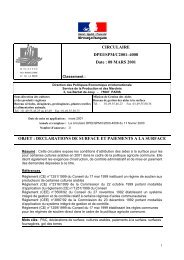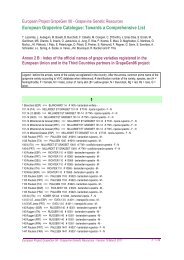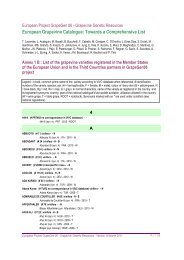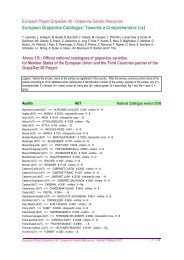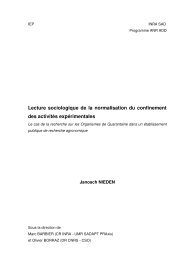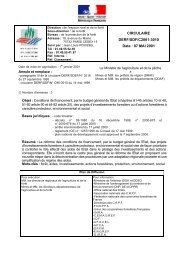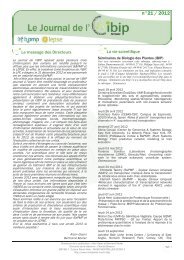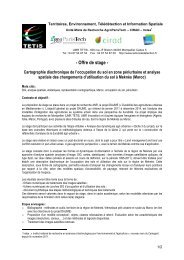Prospects for silvoarable agroforestry at the European scale - Inra
Prospects for silvoarable agroforestry at the European scale - Inra
Prospects for silvoarable agroforestry at the European scale - Inra
Create successful ePaper yourself
Turn your PDF publications into a flip-book with our unique Google optimized e-Paper software.
<strong>Prospects</strong> <strong>for</strong> <strong>silvoarable</strong><br />
agro<strong>for</strong>estry<br />
<strong>at</strong> <strong>the</strong> <strong>European</strong> <strong>scale</strong><br />
The end-users point of view...
Farmers’ issues<br />
The SAFE project surveyed farmers from<br />
7 <strong>European</strong> countries to describe <strong>the</strong>ir<br />
<strong>at</strong>titude to modern agro<strong>for</strong>estry (WP2)
14 regions – 270 farmers
Are <strong>European</strong> farmers ready <strong>for</strong><br />
Agro<strong>for</strong>estry?<br />
Face to face interviews with cereal farmers<br />
who knew nothing about agro<strong>for</strong>estry
Are <strong>European</strong> farmers ready <strong>for</strong><br />
Agro<strong>for</strong>estry?<br />
60%<br />
Would you <strong>at</strong>tempt a <strong>silvoarable</strong> project ?<br />
50%<br />
48%<br />
40%<br />
36%<br />
30%<br />
20%<br />
16%<br />
10%<br />
0%<br />
Yes Don't know No<br />
48 % of <strong>European</strong> farmers interviewed would be interested to<br />
introduce agro<strong>for</strong>estry plots on <strong>the</strong>ir farm…<br />
(From 20% to 80 %, from Nor<strong>the</strong>rn to Mediterranean countries)
Are <strong>European</strong> farmers ready <strong>for</strong><br />
Agro<strong>for</strong>estry?<br />
They would envisage planting 20% of <strong>the</strong>ir farm with<br />
agro<strong>for</strong>estry, in fertile or medium soil<br />
But <strong>the</strong>re is a strong variability depending on <strong>the</strong><br />
farmers’ objectives…
AF meets 8 objectives <strong>for</strong> <strong>European</strong> farmers<br />
• Diversific<strong>at</strong>ion<br />
• Profitability<br />
• Reversibility<br />
• Feasibility<br />
• Environnemental Impact<br />
• Public perception of farmers activity<br />
• Pleasure<br />
• Social arrangement
Diversific<strong>at</strong>ion
To diversify by planting trees in<br />
agricultural land<br />
LER = 1 LER > 1<br />
Agro<strong>for</strong>estry is a progressive and productive<br />
diversific<strong>at</strong>ion of <strong>the</strong> farm activities
Profitability<br />
This 60 year old walnut grove (156 trees/ha) is valued <strong>at</strong> 120 000 euros of<br />
timber per hectare
Profitability<br />
% of Farm Gross Margin without AF<br />
175<br />
150<br />
125<br />
100<br />
75<br />
Farm with 8% <strong>silvoarable</strong> area<br />
Farm with 100 % of cropping area<br />
178% 180% 191% 183%<br />
Will significantly increase<br />
<strong>the</strong> farm income in <strong>the</strong> long term<br />
(x2 with walnut trees on 50%;<br />
x1.2 with wild cherry on 20%)<br />
50<br />
0% 20% 40% 60% 80% 100% 120%<br />
% of <strong>the</strong> first tree rot<strong>at</strong>ion
Profitability<br />
But farmers will not adopt agro<strong>for</strong>estry<br />
only <strong>for</strong> long term profitability.<br />
Profitability is relevant <strong>for</strong> successors who<br />
will inherit of <strong>the</strong> trees.<br />
The cash income during <strong>the</strong> first years<br />
after <strong>the</strong> tree plant<strong>at</strong>ion is <strong>the</strong> major<br />
financial concern <strong>for</strong> <strong>the</strong> farmer.
Reversibility
Feasibility<br />
•Easy to master<br />
•1 to 2 days/year/ha<br />
• Labour optimiz<strong>at</strong>ion
Complying with GAEC and<br />
<strong>European</strong> Directives...<br />
Improving profitability<br />
(hunting, inputs<br />
Environmental impact
Farmer’s image
Pleasure and farm landscape
Tenant farmers and land owners can agree<br />
to manage agro<strong>for</strong>estry plots<br />
Social arrangement
Wh<strong>at</strong> prospect <strong>for</strong> modern<br />
<strong>silvoarable</strong> agro<strong>for</strong>estry in<br />
Europe ?<br />
The SAFE project predictions (WP8)
Wh<strong>at</strong> potential in Europe?<br />
• 90 Millions of hectares suitable <strong>for</strong> AF<br />
• Including 65 millions d’hectares with<br />
environmental problems th<strong>at</strong> AF could mitig<strong>at</strong>e<br />
• But <strong>the</strong> concept is still confidential in most<br />
countries (France is leading)
Where can SAF yield environmental benefits?<br />
Arable land<br />
Potential productive<br />
growth of SAFE<br />
tree species<br />
n<strong>at</strong>ural<br />
conditions<br />
Problems of erosion<br />
Low landscape diversity<br />
N-leaching<br />
‚Target area‘
Target areas<br />
650’000 km 2<br />
(40% of <strong>European</strong><br />
arable land)<br />
Arable land<br />
Potential productive<br />
growth of SAFE<br />
tree species<br />
n<strong>at</strong>ural<br />
conditions<br />
Problems of<br />
erosion<br />
N-leaching<br />
low landscape diversity<br />
‚Target area‘
Wh<strong>at</strong> future <strong>for</strong> Agro<strong>for</strong>estry ?<br />
The French case<br />
• Be<strong>for</strong>e 2001, agro<strong>for</strong>estry was not taken into account in <strong>the</strong><br />
French Regul<strong>at</strong>ions (CAP)<br />
• In 2001, farmers obtained 3 re<strong>for</strong>ms <strong>for</strong> <strong>silvoarable</strong> systems:<br />
1. The intercrop area became eligible to <strong>the</strong> crop payment (1st pillar)<br />
2. Owners could get a grant <strong>for</strong> tree plant<strong>at</strong>ion (2nd pillar)<br />
3. Farmers could benefit from an agro<strong>for</strong>estry AEM<br />
After 2001,<br />
we observe a development of a modern agro<strong>for</strong>estry…
Wh<strong>at</strong> future <strong>for</strong> modern <strong>silvoarable</strong> systems ?<br />
The French case<br />
1400<br />
1200<br />
Evolution of annual area planted in agro<strong>for</strong>estry<br />
Years 2000-2005<br />
1 500 ha<br />
in 2006<br />
1000<br />
hectare<br />
800<br />
600<br />
400<br />
200<br />
0 ha in<br />
2001<br />
0<br />
2000 2001 2002 2003 2004 2005 2006<br />
Year<br />
Cumul<strong>at</strong>ed Existing In study Applicant
Wh<strong>at</strong> future <strong>for</strong> Agro<strong>for</strong>estry ?<br />
The French case<br />
60%<br />
50%<br />
Interested<br />
Undecided<br />
Agains t<br />
40%<br />
30%<br />
20%<br />
10%<br />
0%<br />
Interview<br />
Phone call<br />
Evolution of <strong>the</strong> farmers’ interest 2 years after <strong>the</strong> interviews...
Wh<strong>at</strong> future <strong>for</strong> Agro<strong>for</strong>estry ?<br />
The French case<br />
Interested<br />
Undecided<br />
Agains t<br />
60%<br />
50%<br />
40%<br />
30%<br />
20%<br />
10%<br />
70 % of <strong>the</strong><br />
interested farmers<br />
have already<br />
initi<strong>at</strong>ed a project<br />
0%<br />
Interview<br />
Phone call<br />
Farmers maintained <strong>the</strong>ir interest 2 years after <strong>the</strong> interviews...
Wh<strong>at</strong> future <strong>for</strong> Agro<strong>for</strong>estry ?<br />
The French case<br />
• It is considered in France th<strong>at</strong> 20% of farmers may<br />
introduce agro<strong>for</strong>estry on 10% of <strong>the</strong>ir farm within <strong>the</strong> next<br />
20 years. This would result in 500 000 ha of agro<strong>for</strong>estry.<br />
• It would reduce French agriculture production by less than<br />
2%.<br />
• It would produce enough high quality timber to meet France<br />
needs <strong>for</strong> high quality timber in 2050.<br />
• The environmental impact would be very positive
But existing regul<strong>at</strong>ions have to be improved<br />
• The subsidy <strong>for</strong> tree plant<strong>at</strong>ion is currently not available <strong>for</strong><br />
most farmers : <strong>the</strong> regul<strong>at</strong>ions limit grants to experimental<br />
projects including a follow-up work by a research institute!<br />
• The AEM <strong>for</strong> agro<strong>for</strong>estry is no longer available, and was<br />
only applied in two French Provinces.
In France also, <strong>the</strong> future of agro<strong>for</strong>estry<br />
is <strong>the</strong>re<strong>for</strong>e not bright<br />
End-users need improvements of n<strong>at</strong>ional<br />
policies th<strong>at</strong> would be facilit<strong>at</strong>ed by a<br />
<strong>European</strong> example
Wh<strong>at</strong> future <strong>for</strong> Agro<strong>for</strong>estry ?<br />
80% of <strong>the</strong> farmers we interviewed want to be contacted again<br />
Most of <strong>the</strong>m want to visit some concrete experiences be<strong>for</strong>e taking decisions<br />
“Your system is fantastic! Sorry to tell you<br />
th<strong>at</strong>, but if you don’t succeed to change <strong>the</strong><br />
<strong>European</strong> regul<strong>at</strong>ions to take into account <strong>the</strong><br />
agro<strong>for</strong>estry specific<strong>at</strong>ions, you are an idiot!<br />
Sorry to tell you th<strong>at</strong> but it’s true!!”<br />
Mr Albert F. February 2004 – Champlitte France
But policy is ano<strong>the</strong>r story…



